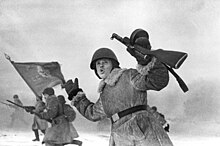
PPD-40
| PPD | |
|---|---|
  PPD-34 & PPD-34/38 | |
| Type | Submachine gun |
| Place of origin | Soviet Union |
| Service history | |
| In service | 1935–45 |
| Used by | See Users |
| Wars | Spanish Civil War Winter War Second Sino Japanese War World War II Korean War Hukbalahap Rebellion 1958 Lebanon crisis Lebanese Civil War[1] |
| Production history | |
| Designer | Vasily Degtyaryov |
| Designed | 1934 |
| Produced | 1934–1942;[2] most in 1940 |
| No. built | Approx. 90,000 |
| Variants | PPD-34, PPD-34/38, PPD-40 |
| Specifications | |
| Mass | 3.2 kg (7.1 lb) empty |
| Length | 788 mm (31.0 in) |
| Barrel length | 273 mm (10.7 in) |
| Cartridge | 7.62×25mm Tokarev |
| Action | Blowback, open bolt |
| Rate of fire | 800–1000 rounds/min |
| Muzzle velocity | 490 m/s (1,600 ft/s) |
| Effective firing range | 200 m (219 yd) |
| Feed system | 25-round detachable box magazine 71-round detachable drum magazine |
The PPD (Pistolet-Pulemyot Degtyaryova, Russian: Пистоле́т-пулемёт Дегтярёва, Degtyaryov's machine pistol) is a submachine gun originally designed in 1934 by Vasily Degtyaryov. The PPD had a conventional wooden stock, fired from an open bolt, and was capable of selective fire. It was replaced by the PPSh-41.

History

Developed in the Soviet Union by arms designer Vasily Degtyaryov. The PPD was designed to chamber the new Soviet 7.62×25mm Tokarev pistol cartridge, which was based on the 7.63×25mm Mauser cartridge used in the Mauser C96 pistol. The later PPD models utilized a large drum magazine for ammunition feeding.

The PPD officially went into military service with the Red Army in 1935[3] as the PPD-34, although it was not produced in large quantities. Production issues were not solved until 1937; in 1934 only 44 were produced, in 1935 only 23; production picked up in 1937 with 1,291 produced, followed by 1,115 produced in 1938 and 1,700 produced in 1939.[4] It saw use with the NKVD internal forces as well as border guards.[citation needed] The PPD was decommissioned entirely in 1939 and factory orders cancelled following a directive of the People's Commissariat of Defence Industry; the decision was quickly reversed, though, after the personal intervention of Degtyaryov with Stalin, with whom he had a good personal relationship.[4][5] During the Winter War in 1939 with Finland, an acute lack of individual automatic weapons even led to the reintroduction of the stockpiled Fedorov Avtomats into service.[6]

In 1938 and 1940, modifications were designated PPD-34/38 and PPD-40 respectively, and introduced minor changes, mostly aimed at making it easier to manufacture. Mass production began in 1940, a year in which 81,118 PPDs were produced. Nevertheless, the PPD-40 was too labor- and resource-expensive to mass-produce economically, most of its metal components being produced by milling.[4] Although it was used in action in World War II, it was officially replaced by the superior and cheaper PPSh-41 by the end of 1941.[citation needed] Shpagin's great innovation in Soviet automatic weapons manufacturing was the large-scale introduction of stamped metal parts, particularly receivers; the PPSh also had a muzzle climb compensator which significantly improved accuracy over the PPD. In 1941 only 5,868 PPDs were made, compared to 98,644 PPSh and in the following year almost 1.5 million PPSh were produced.[4]

PPDs captured by Finnish forces during the Winter War and Continuation War were issued to coastal and home guard troops and kept in reserve until approximately 1960.[7] PPD-34/38 and PPD-40 submachine guns captured by the Wehrmacht were given the designations MP.715(r) and MP.716(r) respectively.

A number of PPD-like submachine guns were also manufactured in a semi-artisanal way by gunsmiths among the hundreds of thousands of Soviet partisans. These guns, even when made as late as 1944, used milling because metal stamping requires large industrial facilities that were not available to the partisans. There are no firm numbers about how many were made, but there were at least six partisan gunsmiths each making his own model series. One of them is known to have produced 28 such sub-machine guns in approximately two years.[8]

Users

 Albania[9]
Albania[9] Republic of China: Received 3,000 during the Second Sino Japanese War.
Republic of China: Received 3,000 during the Second Sino Japanese War. Finland[10][11]
Finland[10][11] Nazi Germany: Captured PPD-34/38s designated the Maschinenpistole 716(r). Captured PPD-40s designated the Maschinenpistole 715(r).
Nazi Germany: Captured PPD-34/38s designated the Maschinenpistole 716(r). Captured PPD-40s designated the Maschinenpistole 715(r). Poland
Poland Lebanese Forces
Lebanese Forces North Korea[7]
North Korea[7] Hukbalahap[7]
Hukbalahap[7] Slovakia: Used by Slovak forces on the Eastern Front.[12]
Slovakia: Used by Slovak forces on the Eastern Front.[12] Soviet Union
Soviet Union Spain: Use of PPD-34/38 by the Spanish Republican Army during Spanish Civil War.[13][14]
Spain: Use of PPD-34/38 by the Spanish Republican Army during Spanish Civil War.[13][14] Yugoslavia: 5,000 were delivered from Soviet Union during 1944-1945.[15]
Yugoslavia: 5,000 were delivered from Soviet Union during 1944-1945.[15]
See also
References
- ^ "Lebanese Forces : The Weapons: Sub Machine Guns (SMG)". 2016-03-03. Archived from the original on 2016-03-03. Retrieved 2022-11-23.
- ^ "В декабре 1942 г. из-за сложности конструкции ППД был снят с вооружения РККА и его производство было прекращено"
КПСС и строительство советских вооруженных сил. (Коллектив авторов). 2е изд. М., Воениздат, 1967; стр.277 - ^ Пистолет-пулемет Дегтярева ППД-34 (in Russian), RU, archived from the original on March 11, 2007, retrieved August 25, 2008
- ^ a b c d Болотин, Давид (1995). История советского стрелкового оружия и патронов (in Russian). Полигон. pp. 105–112. ISBN 5-85503-072-5.; figure for 1936 is not reported
- ^ Kalashnikov, Mikhail (2006). The Gun that Changed the World. Polity. p. 40. ISBN 978-0-7456-3692-4.
- ^ Monetchikov, Sergei (2005). История русского автомата [The History of Russian Assault Rifle] (in Russian). St. Petersburg: Military Historical Museum of Artillery, Engineers and Signal Corps. pp. 18–19. ISBN 5-98655-006-4.
- ^ a b c McNab, Chris (20 May 2014). Soviet Submachine Guns of World War II: PPD-40, PPSh-41 and PPS. Weapon 33. Osprey Publishing. p. 22. ISBN 9781782007944.
- ^ Сергей Плотников, "Партизанские Самоделки", Оружие 2000/4, pp. 46-51
- ^ Jones, Richard D.; Ness, Leland S, eds. (January 27, 2009). Jane's Infantry Weapons 2009/2010 (35th ed.). Coulsdon: Jane's Information Group. ISBN 978-0-7106-2869-5.
- ^ "Machinepistols part 2", Finnish Army ARMY 1918–1945, Jaegerplatoon, retrieved 2011-04-26
- ^ McNab, Chris (2002). 20th Century Military Uniforms (2nd ed.). Kent: Grange Books. p. 67. ISBN 1-84013-476-3.
- ^ "Slovak Armed Forces". 15 September 2020. Archived from the original on 30 January 2021. Retrieved 4 March 2024.
- ^ "Las armas de la Guerra Civil Española", José María Manrique García, Lucas Molina Franco.
- ^ David T. Zabecki, ed. (1998). World War II in Europe: An Encyclopedia, Volume 1. Routledge. pp. 1013–1014. ISBN 0824070291.
- ^ Бранко Богданович. Югославский ТТ по имени «Тетеjац» // журнал «Оружие», № 10, октябрь 2012. стр.42-56
External links
![]() Media related to PPD at Wikimedia Commons
Media related to PPD at Wikimedia Commons

- Basic notes on PPD-34 and PPD-40 (in Russian), RU: Gewehr, 2007-04-11, archived from the original on 2011-09-19, retrieved 2008-05-31.
- ППД-1934\38\40 [PPD-34, PPD-38 and PPD-40] (in Russian), RU: Ucoz, archived from the original on 2008-12-10.
- "Machinepistols part 2", Finnish Army ARMY 1918–1945, Jaegerplatoon, retrieved 2011-04-26.
- The Soviet Union Adopts an SMG: Degtyarev's PPD-34/38
See what we do next...
OR
By submitting your email or phone number, you're giving mschf permission to send you email and/or recurring marketing texts. Data rates may apply. Text stop to cancel, help for help.
Success: You're subscribed now !
